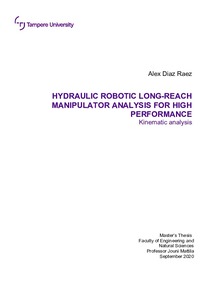Hydraulic Robotic Long-Reach Manipulator Analysis For High Performance: Kinematic analysis
Diaz Raez, Alex (2020)
Diaz Raez, Alex
2020
Konetekniikan DI-ohjelma - Master's Programme in Mechanical Engineering
Tekniikan ja luonnontieteiden tiedekunta - Faculty of Engineering and Natural Sciences
This publication is copyrighted. You may download, display and print it for Your own personal use. Commercial use is prohibited.
Hyväksymispäivämäärä
2020-10-23
Julkaisun pysyvä osoite on
https://urn.fi/URN:NBN:fi:tuni-202010137335
https://urn.fi/URN:NBN:fi:tuni-202010137335
Tiivistelmä
Nowadays, autonomous robots for all different purposes are the state-of-the-art technology, all companies across the industry are implementing all kind of autonomous machines to control and computerize the industrial systems and processes, making errors virtually impossible and, despite all the first investment, the transition pays off in the mid and long-term because of all the time and resources saved.
This new industrial phase, which is a current tendency commonly known as Industry 4.01, focuses on interconnectivity, automation, machine learning, and real-time data. The same trend applies to vehicles or mobile machines (for industrial or non-industrial purposes), the use of fossil fuels is decreasing whereas the implementation of automation and systems of artificial intelligence is strongly increasing day by day.
Heavy-duty hydraulically driven mobile working machines (for mining, construction, forestry, and material handling purposes) are also in constant development for increasing efficiency and performance because of the higher requirements set by the constant growth of this sector. As a result, working machines are increasingly expected to become more precise, and robotics like towards autonomous operation.
This thesis studies the design requirements and sizing for each hydraulic actuator system of the case of study, a long-reach manipulator 4x4 Haulotte HA16 RTJ PRO which is available at the University of Tampere (Hervanta Campus). This hydraulic articulated boom, originally manually driven, is being redesigned into a servo-hydraulic system maintaining the original diesel motor source and taking into account its limited power.
The general work consists of requirements of development, hydraulic engineering designs, component selection, modeling, and simulations towards a new prototyped system meeting the set requirements. During the making of this thesis, the component selection was already done and the scope of the study relies on the kinematic and hydraulic analysis for the vehicle.
Also, this thesis has pursued another objective, which is the compilation of technical data (such as the boom dimensions, original hydraulics, or technical information about the main components) among the different reports about the Haulotte, trying to achieve that the upcoming students or researchers can get clearer ideas and the maximum possible information about the case of study reading this document.
The goals are got from a theoretical viewpoint through equations and hypotheses considered throughout the study, therefore, the results obtained must be taken as approximations. The reason is the coronavirus pandemic, which forced the university and the laboratories to close since the beginning of the semester and some parameters or variables taken may not always coincide with the reality because were taken from a 3D model from the original Haulotte website.
This new industrial phase, which is a current tendency commonly known as Industry 4.01, focuses on interconnectivity, automation, machine learning, and real-time data. The same trend applies to vehicles or mobile machines (for industrial or non-industrial purposes), the use of fossil fuels is decreasing whereas the implementation of automation and systems of artificial intelligence is strongly increasing day by day.
Heavy-duty hydraulically driven mobile working machines (for mining, construction, forestry, and material handling purposes) are also in constant development for increasing efficiency and performance because of the higher requirements set by the constant growth of this sector. As a result, working machines are increasingly expected to become more precise, and robotics like towards autonomous operation.
This thesis studies the design requirements and sizing for each hydraulic actuator system of the case of study, a long-reach manipulator 4x4 Haulotte HA16 RTJ PRO which is available at the University of Tampere (Hervanta Campus). This hydraulic articulated boom, originally manually driven, is being redesigned into a servo-hydraulic system maintaining the original diesel motor source and taking into account its limited power.
The general work consists of requirements of development, hydraulic engineering designs, component selection, modeling, and simulations towards a new prototyped system meeting the set requirements. During the making of this thesis, the component selection was already done and the scope of the study relies on the kinematic and hydraulic analysis for the vehicle.
Also, this thesis has pursued another objective, which is the compilation of technical data (such as the boom dimensions, original hydraulics, or technical information about the main components) among the different reports about the Haulotte, trying to achieve that the upcoming students or researchers can get clearer ideas and the maximum possible information about the case of study reading this document.
The goals are got from a theoretical viewpoint through equations and hypotheses considered throughout the study, therefore, the results obtained must be taken as approximations. The reason is the coronavirus pandemic, which forced the university and the laboratories to close since the beginning of the semester and some parameters or variables taken may not always coincide with the reality because were taken from a 3D model from the original Haulotte website.
